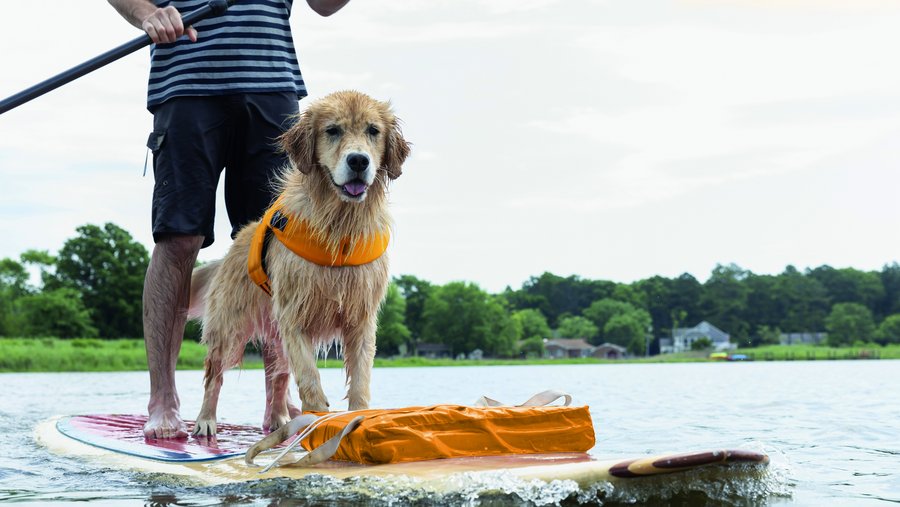What matters: the right board.
If you already have a board or SUP, you should pay attention to the following: It must support the combined weight of you and your dog. For wet fur, add 2–4 kg. Your board can support that? Perfect. Then check whether it has a continuous covering (deck pad). If not, you can retrofit it or simply use a dog mat or a towel. You simply attach this to the board with tension straps. This way, you protect your dog from slipping and your board from unsightly scratches. You are considering buying a new board? Then choose one that is as wide as possible. It is more stable in the water. And your dog can turn around on it without stress. Fins give additional stability; ideally, your board will have three of them. It is always wise to test the board before buying it. You can do this in various stores, rental stations, and SUP schools. By the way: Inflatable boards are not destroyed by dog claws.
Safety first: You need life vests for both.
Whether you wear a life vest yourself is, of course, up to you. With a vest is always safer. This also applies to your dog. Because even if it can usually swim well, it can quickly reach its limits with longer distances and/or stronger currents. In addition, the life vest has an extra advantage: A spirited grip is enough to help your four-legged friend back on the board. The life vest should fit well, but not too tightly and not restrict your dog’s freedom of movement. For the right size, measure from the base of the neck to the beginning of the lumbar spine. You should also measure the neck circumference and the chest circumference at the widest point. In the beginning, a harness will do. However, you should get your dog a life vest at the latest when you set off on longer trips.
It’s better that you first practise by yourself and then with your dog.
Before you get your dog used to the board, you should have mastered the most important skills on it yourself. Two beginners at once are never a good team. Only if you are safe yourself can you bring your dog safely over the water. And above all, give your dog the feeling of safety. You don’t necessarily have to be a pro but should nevertheless be able to master the following basic skills blindfolded: getting on and off the board in the water, riding standing straight, turning, and stopping. Until you have mastered this (if you haven’t already), you can get your dog used to the board on land.
Getting used to the board: dry run.
First, let your dog get to know the board. You can put it in the living room or in the garden. Then you can practice with your best friend to step on the board and do exercises with it. Sit, lie down, stay, and do tricks if you like. The next step is to get your dog used to balancing. To do this, get one or two friends to help you. They will take the board at both ends and lift it slightly. Again, you do exercises with your dog while your helpers move the board slightly. Your dog will learn not to leave the board until you allow it to. Because once on the water, you can easily tip the board and end up in the water. Only when your dog is safe and calm about all of this can you go out on the water.
Of to the water: The first time.
You are ready. You can now go on the water together for the first time. Choose the shallow area of a calm body of water. Preferably on a day when there is as little activity as possible. Then you let your dog get on from the shore. Sit on the board. This way, you can keep it stable and don’t have to climb up behind it. This could otherwise be unsettling for your four-legged friend. Depending on the character of your pet, this exercise is the end of the first day. If your dog is more courageous, you can ask him to sit, lie down, and stay. You will gradually get your best friend used to movement and the first paddle strokes along the shore. It can then come to a kneel and stand, and you can carefully move away from the shore. What you should prepare for: If your four-legged friend changes it position on the board, you need to compensate. So leave your usual place in the middle between the handles, and slide further forward, backward, or slightly to the side. If your dog’s legs start to tremble whilst standing, this is no cause for alarm. But high time for a break. On thing you should absolutely do: Practice capsizing. Because sooner or later it will happen. It’s good if you already know this in case of emergency.
Once you are safely on the board with your dog, you can gradually extend your excursions – up to day trips. In doing so, you will strengthen not only your fitness but also your relationship.

